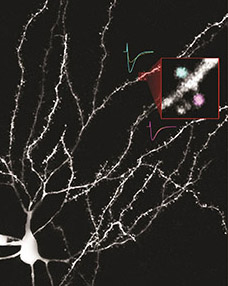
Northwestern Medicine scientists have discovered a new origin for the abnormal involuntary movements associated with Huntington’s disease.
Huntington’s disease is a neurodegenerative genetic disorder whose earliest pathology appears in the striatum, a region of the forebrain involved in the control of movement.
“The degeneration in Huntington’s disease was thought to be a consequence of impaired delivery of a survival signal to the striatum, causing it to wither and die,” said D. James Surmeier, PhD, chair of the Department of Physiology and senior investigator of the study. “We show that at least in the early stages of the disease, this isn’t the case. Rather, the problem stems from a misinterpretation of the survival signal.”
In the past, debilitating movements were attributed to the loss of a protein called the brain-derived neurotrophic factor (BDNF). Its delivery from the cerebral cortex to the striatum supposedly decreased in Huntington’s disease.
However, the scientists were surprised to find that in mice models with early Huntington’s disease, BDNF delivery was normal. Instead, they discovered that striatal neurons failed to respond to BDNF messages in an appropriate way.
Signaling of a protein called tyrosine-related kinase B (TrkBR) was impaired. Stopping a protein known to inhibit TrkBR signaling, called p75 neurotrophic receptor (p75NTR), corrects that problem.

Joshua Plotkin, PhD, ’12 GME, research assistant professor in Physiology, was first author of the study. The findings, published in Neuron, have some immediate implications for the disease.
“This shows us what won’t work as a therapy in Huntington’s disease. This is not trivial because there has been a great deal of effort and money spent on replacing the survival signal,” said Surmeier. “Attempts to stem the brain degeneration in Huntington’s disease by giving a molecule that mimics BDNF will not succeed.”
Currently, there is no cure for Huntington’s disease, but this research may pave the way for one.
“The culprit in the miscommunication is another protein, p75NTR, that could be targeted with drugs or other strategies, like gene therapy,” said Surmeier. “Our work provides an alternative target that is likely to be a viable therapeutic strategy.”
This work was supported by the Cure Huntington’s Disease Initiative Foundation, the JPB Foundation, the Fisher Center for Alzheimer’s Research Foundation and NIH grants NS034696, MH074866 and NS067414.






